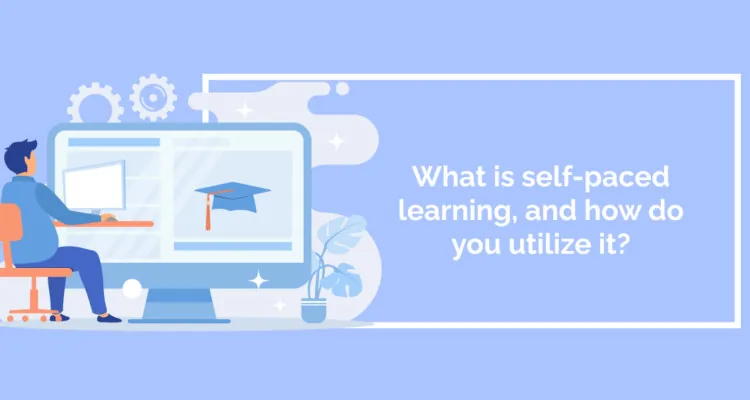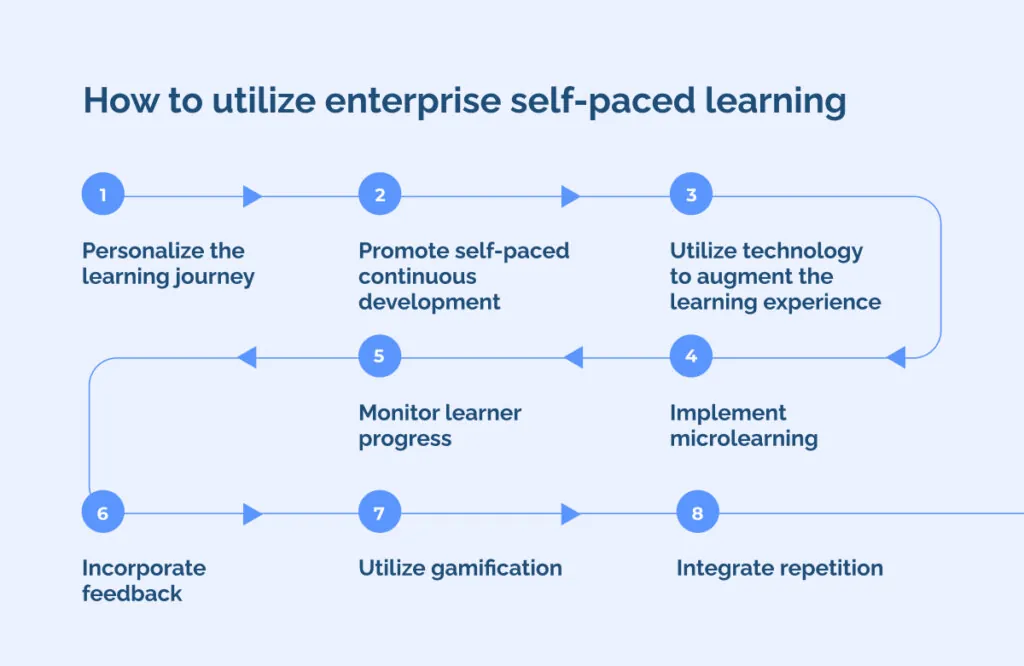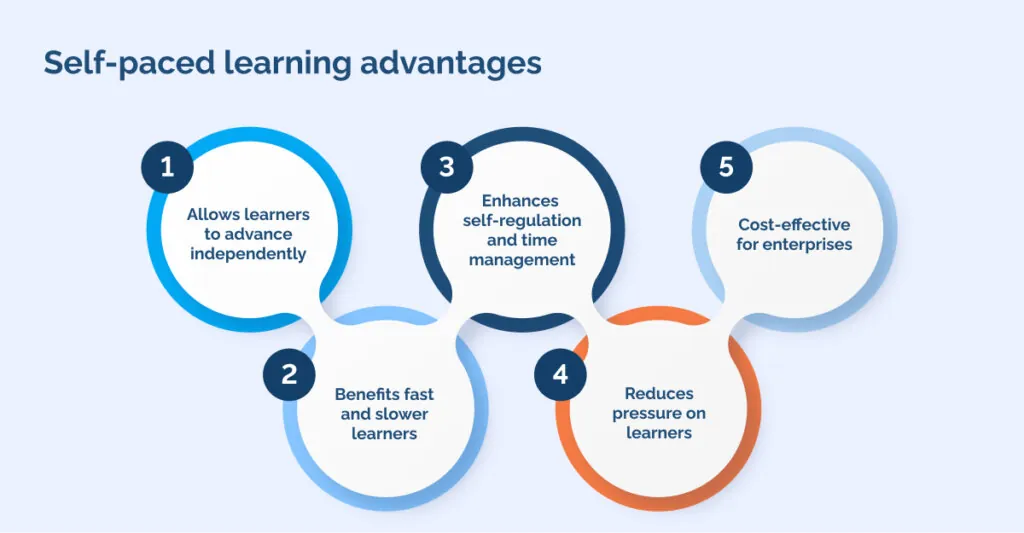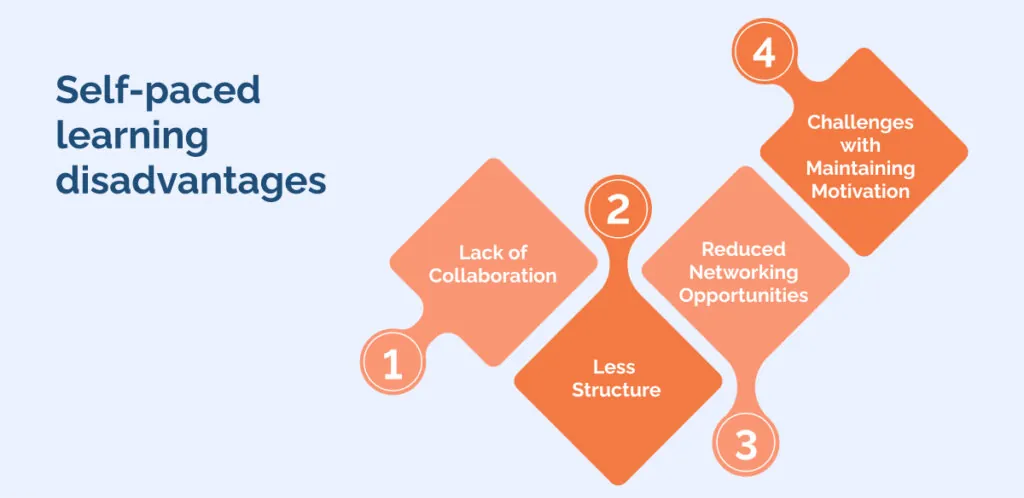
Employee development is a massive part of your organization’s success, and like any measure of success, you may want to control this as tightly as possible.
However, self-paced learning provides an alternative to this approach, where employees often direct their learning experiences with deadlines and goals through an online course.
Understanding what self-paced learning is and how to utilize it can help you optimize your funds as you contribute to the USD 101 billion of the US learning and development market in 2023.
This approach lends itself to a focus on self-paced learning online, showing many learning and development professionals are beginning to favor self-pacing to enhance employee experience as they offer excellent employee training.
This article will explore self-paced learning, covering its definition, strategies for enterprise utilization, advantages, disadvantages, and the role of a Digital Adoption Platform (DAP) in facilitating self-paced learning.
What is self-paced learning?
Self-paced learning is an instructional approach where learners advance through the material independently and according to their set timelines. Unlike traditional classroom or cohort-based learning, the learner, not the instructor, guides self-paced learning.
In this model, learners can dedicate more or less time to specific lessons or course content. The model fosters a personalized learning experience, empowering learners to identify and address their unique needs and interests on their own terms.
How to utilize enterprise self-paced learning

Self-paced learning doesn’t mean a lack of support or structure for the learner. In fact, the best way to ensure self-paced learner success is to give them all the tools, support, and guidance they need from the beginning of their self-pacing journey.
Consider utilizing enterprise self-paced learning to work with each employee to ensure a systematic approach and a successful outcome.
Personalize the learning journey
Tailor self-paced learning to individualized paths that meet employees’ needs, preferences, and goals, recognizing diverse expertise, learning styles, learner behavior, and job responsibilities. This approach enhances motivation and engagement and optimizes learning time.
It can be helpful to collect data on a new staff’s learning needs during employee onboarding and update these yearly as they change.
To create personalized self-paced learning paths, implement the following:
- Competency framework: Utilize frameworks outlining essential skills and knowledge for specific roles to guide personalized learning paths for their learning.
- Skills assessment and gap analysis: Assess the workforce’s capabilities and design self-paced learning initiatives to address identified gaps.
- Manager involvement: Collaborate with employees’ managers to gather input and secure their support for personalized learning.
- Employee engagement: Solicit feedback from employees to align self-paced learning with their individual goals.
- DAP: A digital adoption platform allows you to tailor the learning for individual self-paced learners to ensure they get the best experience.
Promote self-paced continuous development
Promote continuous self-paced learning to acknowledge the dynamic nature of industries, technologies, and job roles.
Continuous learning ensures individuals remain relevant, adaptable, engaged, innovative, and equipped to face evolving business challenges while remaining self-motivated and completing training in their time frame.
For effective continuous self-paced learning, consider:
- Make different courses available: Making a diverse yet relevant variety of courses available to your employees keeps the learning experience fresh and the choice in their hands.
- Offer incentives for learning: Offer learning incentives like cash prizes or paid holidays for completing learning modules, but ensure you keep the power in the hands of employees by offering learning goals for learning quantity.
- Provide various learning communication tools: Provide a regular showcase of different learning styles on the intranet and regular newsletters to promote different approaches to learning.
Utilize technology to augment the learning experience
A technology-driven approach is paramount to enhancing the learning experience in today’s educational landscape. Embracing cutting-edge tools and platforms enables learners to access resources, interactive content, and virtual collaborative spaces.
Utilize various forms of technology to enhance the self-paced learning experience, such as:
- immersive simulations: Realistic scenarios enhance self-paced learning through practical and engaging experiences that embed new data more efficiently.
- AI-driven personalization: Tailored content and guidance based on individual progress and preferences.
- Interactive assessments: Engaging quizzes and exercises promote active participation and knowledge retention.
- Real-time feedback: Instant insights on performance aid continuous improvement in self-paced learning.
- Video conferencing: Connecting learners for virtual discussions for those who choose to connect in this way enhances peer interaction and support while maintaining some level of independence.
- Online forums: Community platforms foster discussions, shared insights, and collaborative problem-solving to mix self-paced learning with teamwork.
Harnessing technology doesn’t just supplement traditional learning—it transforms it into a dynamic, adaptable, and accessible experience, unlocking the full potential of educational opportunities in a rapidly evolving digital age.
Implement microlearning
Microlearning is the latest trend in eLearning and instructional design circles, gaining prominence for good reasons. It brings various benefits, such as enhanced retention rates, increased learner engagement, and cost-effectiveness.
- Structured modules: Break down content into bite-sized modules for easy consumption and focus on specific learning objectives.
- Multimedia elements: Integrate diverse media, such as short instructional videos, infographics, and quizzes, to cater to varied learning preferences.
- Adaptive platforms: Utilize adaptive learning platforms that customize content based on individual progress and performance.
- Personalized learning paths: Enable learners to choose their learning path, allowing them to explore topics at their own pace and based on their interests.
- Progress tracking: Implement robust tracking mechanisms to allow learners to monitor their progress, identify improvement areas, and know when to ask for support.
Consider integrating microlearning elements if you plan to create a self-paced learning program. Examples include bite-sized videos, short quizzes or games, and infographics.
Monitor learner progress
Even in self-paced learning, instructors can track learners’ progress and offer support. Regularly checking learners’ advancement allows for early intervention if anyone falls behind.
- Analytics tools: Use analytics tools to track learner engagement, completion rates, and time spent on various modules.
- Assessment metrics: Implement regular assessments and quizzes to gauge understanding, identify gaps, and tailor support based on performance.
- Feedback loops: Establish continuous feedback loops through surveys or automated feedback mechanisms, allowing learners to provide insights on their experience and needs.
Motivate and support learners by sending nudges based on their activity. For instance, if a learner has been inactive for more than a week, send an email encouraging them to continue and provide resources for support.
Incorporate feedback
Feedback is crucial for effective learning, guiding learners on improvement and motivation. Even in self-paced programs, incorporating some form of feedback is essential.
- Surveys and assessments: Integrate regular surveys and assessments to gather learner feedback on content relevance, engagement, and comprehension.
- Automated feedback: Implement automated feedback mechanisms for assessments, providing instant guidance and insights to learners.
- Interactive platforms: Utilize discussion forums and interactive platforms to encourage learners to share feedback and ask questions for continuous improvement.
If personalized feedback is challenging, automated assessment responses can still support learners.
Utilize gamification
Self-paced learning lacks external sometimes lacks motivating factors like social pressure and deadlines present in instructor-led programs. Gamification ensures these aspects remain, motivating independent learners to achieve goals.
- Points and badges system: Introduce a points and badges system to reward learners for completing modules, creating a sense of accomplishment.
- Leaderboards: Implement leaderboards to foster friendly competition and motivate learners to excel, showcasing their progress relative to peers.
- Scenario-based challenges: Incorporate scenario-based activities or simulations that provide real-world context, making the learning engaging and applicable.
Gamification is a valuable strategy to keep learners engaged. This technique incorporates game-like elements like leaderboards, learning badges, scenario-based activities, or simulations.
Integrate repetition
Repetition is vital for effective learning, ensuring we deeply store information in our brains. Self-paced learning often lacks opportunities for repetition present in cohort-based learning.
- Varied content presentation: Present information in different formats, such as text, videos, and quizzes, to reinforce concepts.
- Spaced repetition: Implement a spaced repetition strategy, revisiting key information at intervals to enhance retention.
- Interactive review sessions: Integrate interactive review sessions or activities, encouraging learners to revisit and reinforce learned material.
Self-paced learning advantages

Now you understand how to utilize self-paced learning, let’s examine the advantages you will reap when employees begin to learn independently.
Allows learners to advance independently
Self-paced learning offers the advantage of allowing learners to progress through the material at their speed.
Doing so increases the likelihood of success, recognizing that individuals learn at different rates. Factors like disabilities, learning difficulties, caregiving responsibilities, parenthood, or full-time employment can influence learning speed.
Benefits fast and slower learners
Self-paced learning supports those who need more time and benefits faster learners. They can proceed without feeling held back, swiftly navigating through the material at their own pace.
Enhances self-regulation and time management
Self-paced learning fosters autonomy, enabling learners to develop self-regulation and time-management skills. The absence of strict deadlines encourages the cultivation of valuable life and professional skills.
Reduces pressure on learners
Self-paced learning alleviates the burden on learners by minimizing test and social anxiety. Learners can complete assignments when ready, avoiding unnecessary stress and optimizing success.
Cost-effective for enterprises
Self-paced learning proves cost-effective for organizations by reducing expenses associated with instructional designers, instructors, and eLearning software. Open enrollment periods contribute to overall cost efficiency in training and development programs.
Self-paced learning disadvantages

Despite the advantages of self-paced learning, it may not always be suitable or universally beneficial. Here are four drawbacks and strategies to address them:
Lack of Collaboration
Self-paced learning often lacks group work and interaction. To counter this, incorporate asynchronous collaboration, such as discussion boards, enhancing social learning opportunities.
Less Structure
Compared to cohort-based learning, self-paced learning can be less structured. To assist learners, provide guidelines on structuring their work, suggesting completion targets, like one module per week.
Reduced Networking Opportunities
Self-paced learning diminishes incidental networking opportunities. To overcome this, encourage participants to share LinkedIn profiles or email addresses, facilitating connections outside the program.
Challenges with Maintaining Motivation
The independent nature of self-paced learning can lead to demotivation. Counteract this by ensuring the course is stimulating and engaging. Explore incorporating elements like microlearning and gamification to enhance motivation.
How does a DAP help with self-paced learning?

A DAP (digital adoption platform) can provide learners with the structure and framework to ensure success.
It can show your self-paced employees that they are not forgotten or ignored despite learning independently, and you provide them with the tools to guide them on the path to success.
Personalized Guidance
Tailoring guidance to individual progress and learning preferences ensures that each learner receives targeted support, fostering a more effective and personalized self-paced learning experience.
This approach accommodates diverse learning styles, creating a dynamic and adaptive learning environment.
Interactive Tutorials
Providing hands-on, interactive tutorials goes beyond traditional teaching methods, actively engaging learners in practical skill development. These tutorials offer immersive learning experiences, encouraging active participation and enhancing the retention of acquired skills.
Real-time Assistance
Offering immediate support and guidance through in-app prompts and assistance features creates a responsive and learner-centric environment.
Learners can navigate challenges with real-time assistance, ensuring a seamless and uninterrupted self-paced learning journey.
Progress Tracking
Monitoring and displaying learners’ progress enables self-assessment and empowers learners to set and achieve their goals.
This visual representation of progress is a motivational tool that fosters a sense of accomplishment and encourages continued engagement.
Adaptive Learning Paths
Customizing learning paths based on individual strengths, weaknesses, and pace ensures that each learner receives content tailored to their needs.
This adaptability enhances the effectiveness of self-paced learning, promoting a personalized and efficient educational experience.
User Feedback Mechanisms
Incorporating user feedback tools becomes crucial to refining the platform’s effectiveness.
This two-way communication fosters a collaborative learning environment where user insights contribute to continuous improvement, ensuring the platform evolves with learner needs.
Continuous Updates
Ensuring content remains current, reflecting industry trends and best practices for ongoing relevance, is essential for a dynamic, self-paced learning platform.
Continuous updates guarantee learners access to up-to-date information, enhancing the platform’s overall educational value. This commitment to currency reinforces the platform’s reliability and effectiveness in supporting ongoing learning initiatives.
Offer continuous support to improve success rates for self-paced learners
Self-paced learning doesn’t mean telling your employees to get on with their personal development alone.
If you want your learners to be successful, equip them with all the tools, guidance, and strategies tailored to their needs straight from the beginning and make yourself available to answer any questions throughout their learning journey.
This approach ensures learners retain their independence, saving your organization money from not having to teach them using costly in-person resources or relying too heavily on a learning management system (LMS). A self-paced course optimizes funds as learners regularly complete courses at their own pace.
Consider a structured, self-paced learning approach to allow your staff to learn new skills and guide your enterprise toward success through a culture of outstanding education and autonomy.
Tristan Ovington
Tristan Ovington is a professional senior writer and journalist, specializing in providing expert insights on various topics such as digital adoption, digital transformation, change management, and Cloud apps. He delivers his knowledge through accessible online content that is data-driven and presented in a friendly tone, making it easy for readers to understand and implement.



